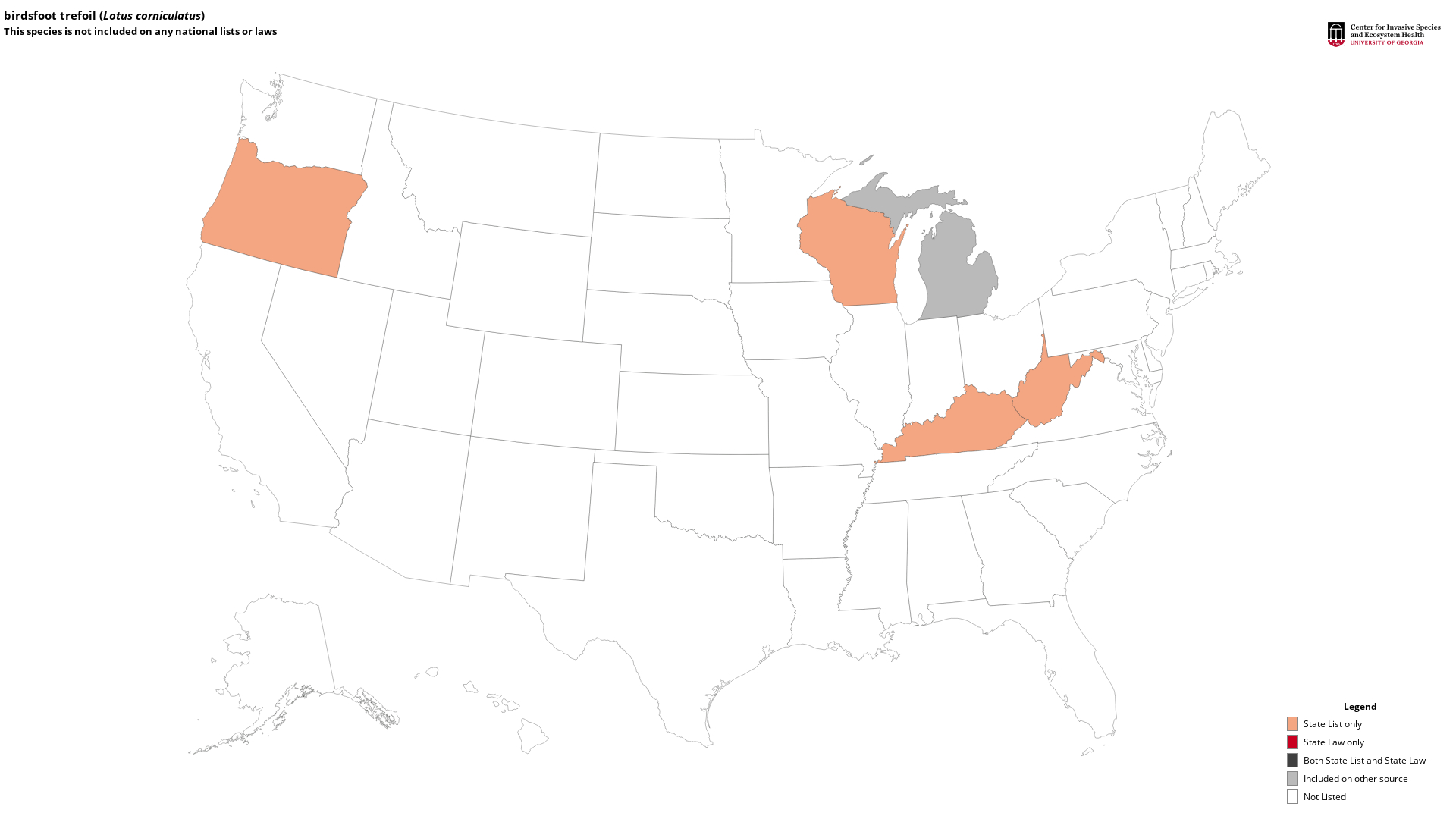birdsfoot trefoil
(Lotus corniculatus)
This species is Introduced in the United States
Appearance
Lotus corniculatus is an invasive low-growing, perennial forb with stems that can reach 2 ft. (0.6 m) long.
Foliage
Leaves are compound (with 5 oval to linear leaflets), stipulate and alternate. Leaflets (upper 3) are 0.5 in. (1.3 cm) long and less than 0.13 in. (0.3 cm) wide; the lower two resemble leaf-like stipules. Flowering occurs from May to August, when yellow, sweet pea-like flowers develop.
Flowers
Flowers develop in clusters of 2-8 on a long peduncle (stalk).
Fruit
Fruits are pods that occur in head-like clusters. Each pod is brown to black, cylindrical, 0.6-1.4 in. (1.5-3.5 cm) long, contains up to 49 seeds and has a persistent style at the apex.
Ecological Threat
Lotus corniculatus is native to Eurasia and North Africa and occurs in pastures, roadsides, wetlands, disturbed grasslands and riparian areas.
Selected Images
Maps
EDDMapS Distribution - This map is incomplete and is based only on current site and county level reports made by experts, herbaria, and literature. For more information, visit www.eddmaps.org
State Lists - This map identifies those states that have this species on their invasive species list or law.
Invasive Listing Sources
- City of Ann Arbor Michigan Parks and Recreation
- Hoffman, R. & K. Kearns, Eds. 1997. Wisconsin manual of control recommendations for ecologically invasive plants. Wisconsin Dept. Natural Resources, Bureau of Endangered Resources. Madison, Wisconsin. 102pp.
- Invasive Plant Association of Wisconsin
- Invasive Plant Species of West Virginia
- Jil M. Swearingen, Survey of invasive plants occurring on National Park Service lands, 2000-2007
- John Randall, The Nature Conservancy, Survey of TNC Preserves, 1995.
- Kentucky Exotic Pest Plant Council - Moderate Threat
- National Park Service, Mid-Atlantic Exotic Plant Management Team Invasive Plant List
- Native Plant Society of Oregon, 2008
- Nonnative Invasive Species in Southern Forest and Grassland Ecosystems
- WeedUS - Database of Plants Invading Natural Areas in the United States
- West Virginia Native Plant Society, Flora West Virginia Project, and West Virginia Curatorial Database System, September 3, 1999
Taxonomic Rank
| Domain: Eukarya |
| Kingdom: Plantae |
| Phylum: Magnoliophyta |
| Class: Magnoliopsida |
| Superorder: Rosanae |
| Order: Fabales |
| Family: Fabaceae |
| Genus: Lotus |
| Lotus corniculatus |
Other System Links
Plants: LOCO6
Bayer: LOTCO
GRIN: 300317
ITIS: 26362
NPDN Pest: PCQBGBA
NPDN Host: 23011
References
Common Name Reference: USDA, NRCS. 2010. The PLANTS Database. National Plant Data Center, Baton Rouge, LA, USA.
Scientific Name Reference: USDA, NRCS. 2010. The PLANTS Database. National Plant Data Center, Baton Rouge, LA, USA.


